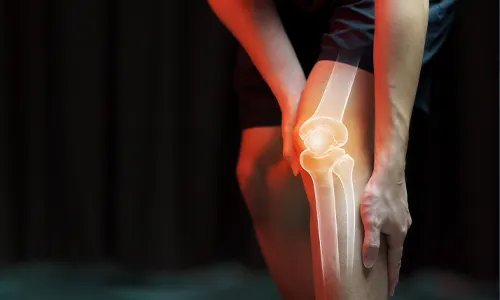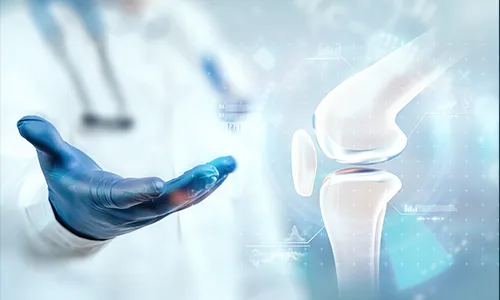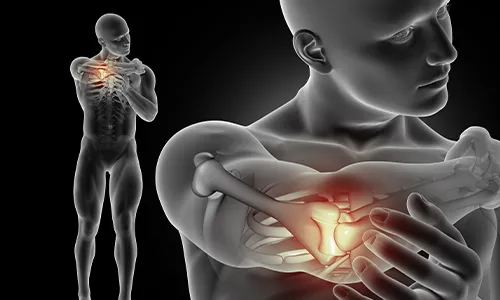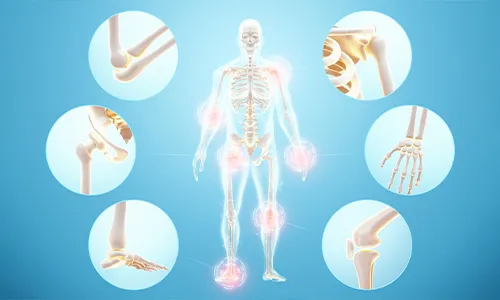

About Bone Cancer
One per cent of all cancers is bone cancer. It is rare and diagnosed when bone cells grow in an abnormal pattern. Though it can start in any bone, it is predominantly diagnosed in legs & arms and pelvis long bones.
Bone cancer can cause persistent pain, swelling or lump over joints and restrictions on joint mobility. It needs screening to diagnose and begin treatment in time for a cure in time.


Risk Factors of Bone Cancer
- Hereditary retinoblastoma, Li-Fraumeni syndrome, and other genetic syndromes increase the probability of bone cancer.
- Paget’s disease of bones, commonly diagnosed in middle-aged people can cause bone cancer.
- Radiation therapy during any other cancer treatment increases the chances of developing bone cancer.
- Chemotherapy during other cancer treatments might cause Osteosarcoma in later life.


How can it be prevented?
- Research is going on to understand the cause and ways to prevent bone cancer.
- Unfortunately, there is no technique to prevent bone cancer currently.
- Therefore, the best option is to early detect bone cancer and start the correct treatment procedure.
- If you fall into any of the above-mentioned risk factors, it is highly advisable to visit a bone cancer specialist.
- They will screen and decide on treatment procedures according to the stage of the bone tumour.


Bone Cancer Symptoms
Common bone tumour symptoms are:
- The constant and excruciating pain that comes & goes frequently
- Swelling around the affected portion of the bone
- Fracture due to weak bone structure
- Fatigue and sudden weight loss
- Worse pain at night
- Not relieved from over-the-counter painkillers


Types of Bone Cancer
Chondrosarcoma
Chondrosarcoma grows in the hip, shoulder, and pelvis areas. Sometimes it happens in the spine too.
It develops slowly and shows symptoms at advanced stages. Treatment usually involves surgery, chemotherapy, and radiation.
Ewing Sarcoma
It is a common type of bone cancer among teenagers and children. It generally grows in the pelvis and leg bones. Sometimes it also develops in soft tissues of limbs, chest, abdomen, and other bones.
Osteosarcoma
Osteosarcoma begins in the cells that form bones. Generally, it grows in the long bones of the
legs and hands. It can also develop in soft tissues and any other bone.
Teenagers, young & older adults, and children are at high risk for this type of bone cancer.


Stages of Bone Cancer
Stage 1:
Bone tumours are still at the primary location and of low grade.
Stage 2:
Cancerous cells are high-grade and still localised.
Stage 3:
High-grade tumours and cancer cells have spread to other parts of the bone. This is a high-risk stage.
Stage 4:
Tumor has spread to other organs of the body.


Diagnosis and Bone Cancer Treatment
Diagnosis of bone cancer includes imaging tests according to the symptoms and signs of the patient.
Imaging tests for diagnosis include:
- Computerised Tomography (CT)
- Bone scan
- X-Ray
- PET (Positron Emission Tomography)
- MRI (Magnetic Resonance Imaging)
The doctor might also recommend surgical or needle-based biopsies. The procedure includes the extraction of a tissue sample from a bone tumour for testing. It helps to analyse the growth of the tumour and the stage of bone cancer.
Methods of biopsy to diagnose bone cancer and bone marrow cancer:
- Needle insertion through the skin into bone tumour
- Surgery to remove a part or entire bone tumour for testing


Standard Protocol for Bone Cancer Treatment
- Removal of a cancerous part of the bone through surgery. In some cases, doctors recommend amputation to stop cancer from spreading to other parts of the bone or body.
- Chemotherapy according to bone tumour condition, age, and other considerations.
- Radiotherapy to eliminate cancer cells in bone/s.
- Supporting medicines during the entire treatment of the bone cancer.


Follow-ups and Cancer Care Plan
- Follow-up appointments are vital to monitor your recovery after bone cancer treatment.
- Doctors might recommend tests, x-rays and scans at these visits during the follow up phase.
- You will be called for follow-up appointments every three months for the first 2 years after the completion of treatment.
- If all goes well, you will require visiting every six months till five years post-treatment.
- After this, doctors recommend yearly appointments to check for any recurrence of symptoms.


FAQ's
-
What is bone marrow cancer?
Bone marrow cancer develops in stem cells that form blood. Leukaemia and Multiple Myeloma are two types of bone marrow cancer.
-
How does bone marrow cancer different from bone cancer?
Bone cancer can develop in any bone of the body. Bone marrow cancer grows in the marrow only.
-
What is the most common bone cancer type?
Osteosarcoma or Osteogenic Sarcoma is the most common type of bone cancer.
-
What are the survival chances of bone cancer?
Early detection of bone tumours is curable. People in the third stage generally live around five years from the diagnosis time.
The timeline varies on a case-to-case basis. It depends upon multiple factors and doctors will explain you the treatment procedure.
-
Why does Osteosarcoma common among adolescent boys?
Generally, Osteosarcoma happens during the rapid bone growth phase. Adolescence being the bodily growth phase, bone cancers are diagnosed mostly among adolescents.
Specialized Doctors at M | O | C
Find the nearest center
Cancer Centres
Mumbai
Pune
Rest of Maharashtra
Gujarat
Delhi NCR
Cancer Clinics
Borivali
+91 9920767626
Book Your Appointment



























.png)









.png)




















.png)



